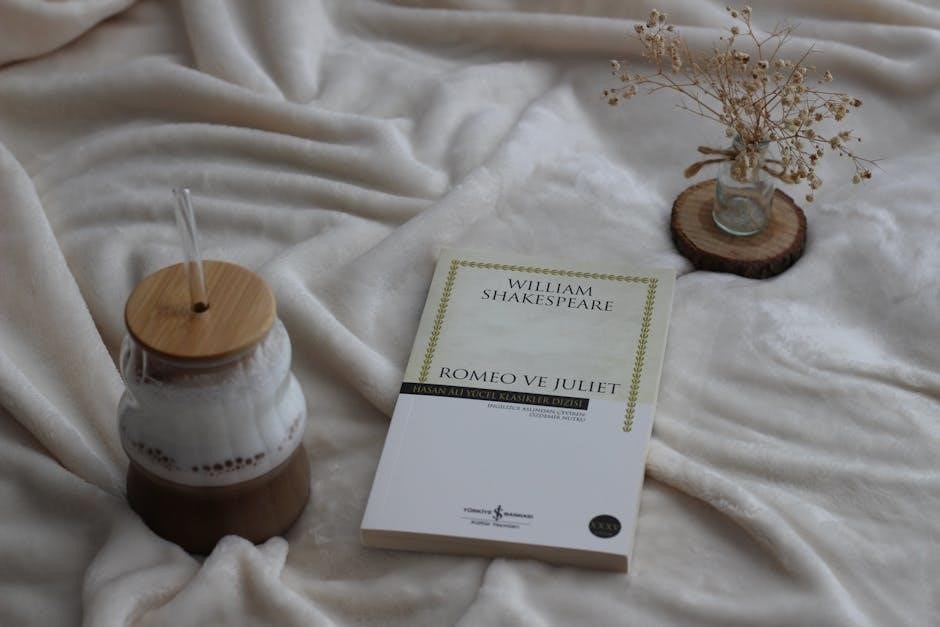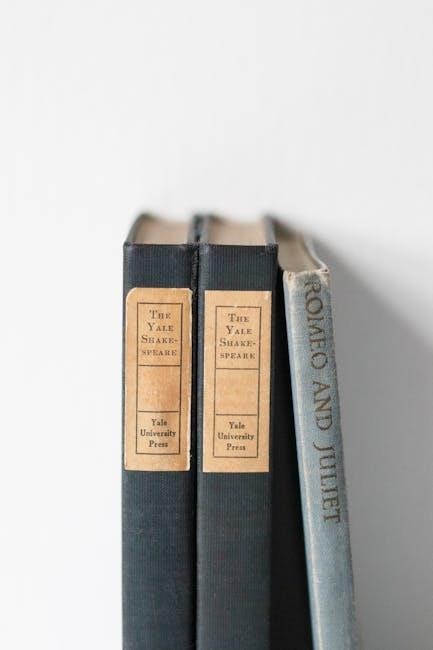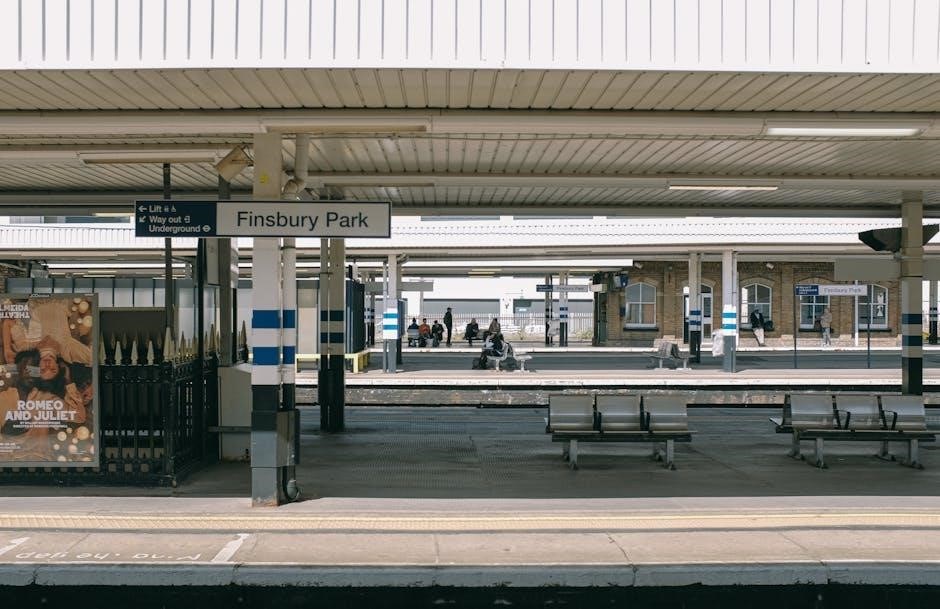The prologue of Romeo and Juliet is a 14-line sonnet delivered by the Chorus, setting the stage in Verona and introducing the feud between two noble families.
Overview of the Prologue
The prologue of Romeo and Juliet is a concise yet powerful introduction to the play, delivered by the Chorus. It outlines the central conflict between the Montagues and Capulets, two noble families in Verona, and hints at the tragic fate of the star-crossed lovers. The prologue, structured as a sonnet, sets the scene in Verona and establishes the themes of rivalry, destiny, and impulsive behavior. It provides essential background information, preparing the audience for the unfolding drama and its inevitable tragic conclusion. This opening passage is crucial for understanding the play’s themes and setting the emotional tone.

Significance of the Prologue in the Play
The prologue holds immense significance as it frames the narrative of Romeo and Juliet, offering a roadmap to the play’s tragic events. By introducing the feud and fate, it creates anticipation and sets the tone for tragedy. The Chorus’s commentary bridges the gap between the audience and the story, providing context and emotional preparation. This opening encapsulates Shakespeare’s dramatic technique, emphasizing fate and inevitability. It not only outlines the plot but also highlights the destructive nature of the families’ rivalry, making it a pivotal element in the play’s structure and thematic development. Its impact endures through its brevity and depth.

Structure and Content of the Prologue
The prologue is a 14-line sonnet, delivered by the Chorus, setting the scene in Verona and introducing the conflict between the Montagues and Capulets. Its structure follows Shakespeare’s traditional rhyme scheme, emphasizing fate and the destructive nature of their feud, while previewing the tragic events to unfold.
The Chorus and Its Role
The Chorus in Romeo and Juliet serves as a narrator, guiding the audience through the play’s events. Appearing at the beginning and between acts, it provides context and foreshadows key plot developments. Unlike other characters, the Chorus remains neutral, offering an external perspective that heightens the emotional impact. Its role is to set the tone, clarify motivations, and prepare the audience for the unfolding drama, making it a crucial element in Shakespeare’s storytelling technique. The Chorus’s commentary adds depth and underscores the inevitability of the tragic outcome, enhancing the play’s dramatic tension and thematic resonance.
Key Themes Introduced in the Prologue
The prologue of Romeo and Juliet introduces central themes such as the feud between the Montagues and Capulets, fate, and the destructive nature of conflict. It establishes the tragic tone, highlighting the inevitability of the lovers’ doomed fate. The Chorus emphasizes the cyclical violence and ancient grudge that fuels the families’ hatred. Love is presented as a potential redemptive force, yet it is overshadowed by the inexorable pull of fate. These themes set the stage for the play’s exploration of loyalty, passion, and the devastating consequences of unchecked rivalry, creating a foundation for the tragic events that unfold. The prologue’s concise yet powerful language encapsulates the play’s emotional and dramatic core.

Historical and Cultural Context
The prologue reflects Verona’s Italian setting, drawing on historical feuds and cultural traditions, while also showcasing Shakespeare’s Elizabethan theatrical influences and narrative style.
The Feud Between the Montagues and Capulets
The prologue establishes the centuries-old rivalry between the Montagues and Capulets, two noble families in Verona. This “ancient grudge” fuels ongoing violence and societal division. The feud, rooted in pride and lineage, transcends generations, fostering hatred and mutual distrust. Its intensity escalates tensions, making Verona a city torn by civil strife. Shakespeare uses this conflict to highlight themes of loyalty, vengeance, and fate. The prologue sets the stage for a tragic narrative, where the families’ animosity ultimately seals the destiny of their children, Romeo and Juliet, whose love becomes a symbol of hope amidst the cycle of violence and despair.
Verona as the Setting
Verona, a city in northern Italy, serves as the backdrop for Romeo and Juliet. The prologue establishes Verona as a place of beauty and conflict, where ancient grudges simmer beneath its picturesque surface. The city’s history and culture provide a rich tapestry for the story, with its noble families and public spaces like the Capulets’ orchard. Verona’s setting symbolizes both romance and tragedy, creating a vivid atmosphere that immerses the audience in the world of the play. The city’s identity is deeply intertwined with the fortunes and misfortunes of its characters, making it a central element in the narrative’s emotional landscape.
Language and Style in the Prologue
The prologue uses a sonnet structure, employing poetic devices like metaphor, alliteration, and dramatic irony. Shakespeare’s rich language sets the tone and foreshadows the tragic events, engaging the audience deeply.
Use of Sonnet Structure
The prologue of Romeo and Juliet is crafted as a traditional Shakespearean sonnet, consisting of 14 lines with a rhyme scheme of ABAB CDCD EFEF GG. This structure emphasizes the poetic and lyrical quality of the introduction, setting a tone of elegance and tragedy. The use of iambic pentameter creates a rhythmic flow, engaging the audience and preparing them for the dramatic events to unfold. Shakespeare employs this structure to succinctly introduce the central themes of the play, including the feud between the Montagues and Capulets, the setting in Verona, and the inevitable fate of the star-crossed lovers. The sonnet’s brevity and poetic richness make it a powerful opening to the play, foreshadowing the tragic events while capturing the audience’s attention immediately.
Dramatic Irony and Foreshadowing
The prologue of Romeo and Juliet masterfully employs dramatic irony and foreshadowing to engage the audience and heighten tension. By revealing the ultimate fate of the “star-cross’d lovers” and the enduring nature of the feud, the Chorus creates a sense of inevitability. This knowledge places the audience in a position of tragic awareness, as they foresee the heartbreaking conclusion while the characters remain oblivious. Such techniques not only deepen the emotional impact but also underscore the themes of fate and the destructive nature of the families’ rivalry, setting the stage for the tragic events that will unfold.

Themes and Motifs in the Prologue
The prologue introduces themes of love vs. hate, fate, and conflict, setting the tone for the tragic narrative. It highlights the enduring feud and doomed love story.
The Theme of Fate
The prologue establishes fate as a central theme, foreshadowing the inevitable tragic outcome. The Chorus describes the families’ ancient feud as a force beyond control, leading to the lovers’ doom. Shakespeare uses phrases like “star-cross’d lovers” and “death-mark’d love” to emphasize fate’s role. This creates a sense of inevitability, suggesting their destiny is predetermined. The prologue’s dramatic irony prepares the audience for the unavoidable tragedy, heightening emotional engagement. Fate’s presence underscores the helplessness of the characters, trapped in a cycle of violence and love they cannot escape.

Loyalty and Conflict
The prologue highlights the intense loyalty of the Montagues and Capulets to their families, which fuels the relentless conflict. The “ancient grudge” between the households is rooted in loyalty to their names and legacy. This loyalty blinds them to reason, leading to cycles of violence. The prologue emphasizes how this conflict disrupts Verona’s peace, spilling “civil blood” and creating a volatile atmosphere. The Chorus underscores the devastating consequences of prioritizing family loyalty over unity, setting the stage for the tragic events. This clash of loyalties and hatred drives the play’s tension and ultimately seals the lovers’ fate.
The prologue introduces the feuding Montagues and Capulets, establishing their central roles in Verona’s conflict. Romeo and Juliet are hinted at as star-crossed lovers, their fate sealed from the start. The Chorus sets the scene for their tragic destiny, outlining the families’ hatred and its impact on the young lovers. This brief introduction shapes the audience’s expectations for the characters’ journeys.
The Montagues and Capulets are two noble families in Verona, locked in a bitter feud. The prologue highlights their equal dignity and ancient grudge, which fuels the city’s unrest. Their hatred is so deep-rooted that it leads to “civil blood” and “mutiny,” creating a volatile backdrop for the lovers’ story. The families’ pride and animosity drive the play’s tragic events, ultimately sealing the fate of their children. This introduction establishes the societal conflict that Romeo and Juliet must navigate, emphasizing the destructive nature of their families’ rivalry. The prologue ensures the audience understands the gravity of their hatred. The prologue introduces Romeo and Juliet as “star-cross’d lovers,” whose fate is sealed from the start. Their families’ hatred sets the stage for a tragic outcome. The Chorus reveals that their love is doomed, as their families’ feud ensures their destruction. This foreboding highlights the inevitability of their fate, making their ultimate sacrifice deeply poignant. The prologue prepares the audience for the heartbreak that awaits, emphasizing that their love is stronger than the hatred that surrounds them, yet destined to end in sorrow. This sets the tone for the entire play, focusing on their ill-fated destiny. The prologue captivates the audience by establishing the tragic tone and introducing themes of fate and conflict, preparing them for the inevitable heartbreak of the star-cross’d lovers. The prologue skillfully builds anticipation by revealing the ancient feud and the tragic fate of the lovers, drawing the audience into Verona’s tense atmosphere. By outlining the central conflict, it sparks curiosity about how the story unfolds. The mention of “star-cross’d lovers” and inevitable “tragic end” creates suspense, making the audience eager to witness the events that lead to the heartbreaking conclusion. This strategic setup ensures the audience is emotionally invested from the start, heightening their engagement with the unfolding drama. The prologue establishes a somber and tragic tone through its language and imagery. Phrases like “ancient grudge” and “civil blood makes civil hands unclean” evoke a sense of deep-seated conflict and inevitable destruction. The Chorus’s solemn delivery foreshadows the heartbreaking outcome, creating a mournful atmosphere. The use of words like “mutiny” and “tragic end” reinforces the idea of inescapable fate, preparing the audience for the sorrowful events that will unfold. This tone sets the emotional foundation, drawing the audience into the darker themes of the play and emphasizing the inevitability of the lovers’ doomed destiny. The prologue reflects Elizabethan theatre traditions, using a Chorus to frame the story, while its themes of feuds and fate resonate with historical accounts of Verona’s conflicts. In Elizabethan theatre, the prologue served as a narrative device to introduce plays, a tradition Shakespeare mastered in Romeo and Juliet. The Chorus, a common feature, provided context and guided the audience, setting the tragic tone. The prologue’s sonnet structure, with its iambic pentameter and rhyme, reflected the poetic preferences of the time. Elizabethan audiences expected such framing, which helped bridge the gap between the stage and the spectator. This approach not only highlighted the universal themes of fate and conflict but also adhered to the dramatic conventions of Shakespeare’s era, making the prologue a vital element in engaging his contemporaries. Modern interpretations of the prologue in Romeo and Juliet often emphasize its universal themes through innovative storytelling. Directors in film and theatre adapt the Chorus’s role, sometimes using voiceovers or visual storytelling to convey the prologue’s message. The sonnet structure is occasionally reimagined with contemporary language or multimedia elements to engage modern audiences. These adaptations highlight the timeless relevance of the prologue’s themes, such as fate and conflict, while exploring new ways to present Shakespeare’s work. Such interpretations ensure the prologue remains a powerful tool for connecting with diverse audiences in the 21st century. The prologue of Romeo and Juliet has inspired countless adaptations, from classic stage productions to modern film interpretations, cementing its place as a cornerstone of literary and theatrical heritage. The prologue has been creatively adapted in various film and stage productions of Romeo and Juliet. In some versions, the chorus is replaced by narration or visual cues, while others retain the traditional spoken word. Modern adaptations often use innovative techniques, such as projections or voiceovers, to convey the prologue’s message. For example, Baz Luhrmann’s 1996 film adaptation presents the prologue as a news broadcast, emphasizing the timelessness of the conflict. Stage productions have also experimented with choreography and lighting to visually represent the prologue’s themes. These adaptations ensure the prologue remains relevant and impactful across different mediums. Literary critics often highlight the prologue’s role in establishing the play’s tragic framework. Many analyze its use of dramatic irony, where the audience is informed of the inevitable outcome, heightening emotional engagement. The prologue’s sonnet structure and themes of fate and conflict are frequently explored. Critics also examine how the prologue introduces the universal struggle between love and hatred, setting the tone for the entire play. Some scholars focus on the Chorus’s role in guiding the audience’s perspective, while others discuss the prologue’s function in condensing complex themes into a concise, poetic introduction to Verona’s troubled landscape. The prologue of Romeo and Juliet masterfully sets the stage for the tragic tale, introducing themes of fate, conflict, and love. Its concise yet powerful structure remains a cornerstone of literary analysis, offering timeless insights into human emotion and societal strife. The prologue of Romeo and Juliet serves as a concise introduction to the play, outlining the setting in Verona and the longstanding feud between the Montagues and Capulets. It establishes the tragic tone and hints at the inevitable fate of the star-crossed lovers. The Chorus delivers this sonnet, providing context and foreshadowing the events to come. The prologue highlights themes of loyalty, conflict, and fate, while its structured language and dramatic irony engage the audience. Its brevity belies its importance, as it sets the foundation for the narrative and guides the audience’s expectations of the tragic unfolding story. The prologue of Romeo and Juliet is a masterful introduction that encapsulates the play’s core elements. It efficiently establishes the setting, conflict, and tragic tone, making it indispensable to the narrative. The Chorus’s concise yet profound words guide the audience’s understanding, foreshadowing the inevitable doom of the lovers. Its structured sonnet form enhances the play’s poetic depth, while its themes of fate and loyalty resonate throughout. As a literary device, the prologue exemplifies Shakespeare’s skill in condensing complexity, ensuring its enduring relevance in both theatrical and academic contexts, making it a pivotal element in the play’s timeless appeal.The Montagues and Capulets
Romeo and Juliet’s Destiny
Impact of the Prologue on the Audience
Building Anticipation

Setting the Tragic Tone
Cultural and Historical Relevance
Elizabethan Theatre Context
Modern Interpretations of the Prologue

Legacy and Adaptations
The Prologue in Film and Stage Adaptations
of the Prologue in Literary Criticism


Final Thoughts on the Prologue’s Importance
